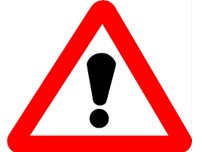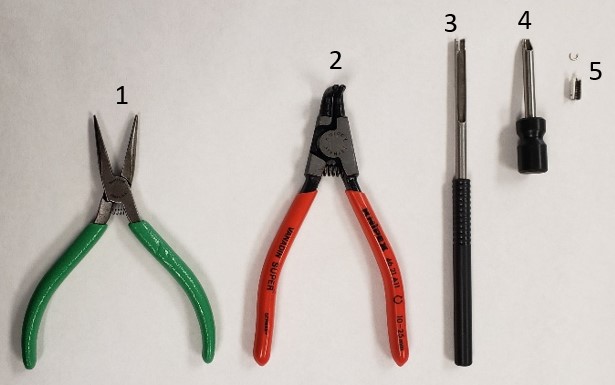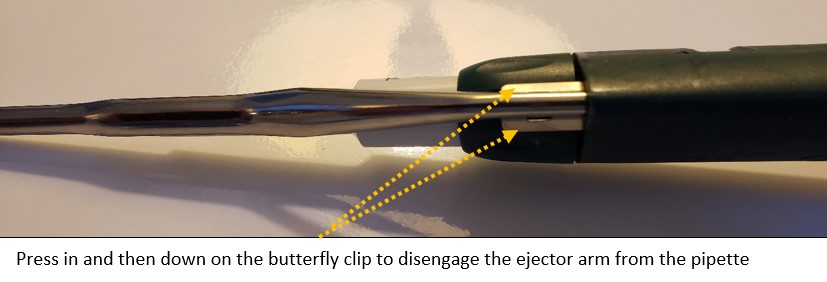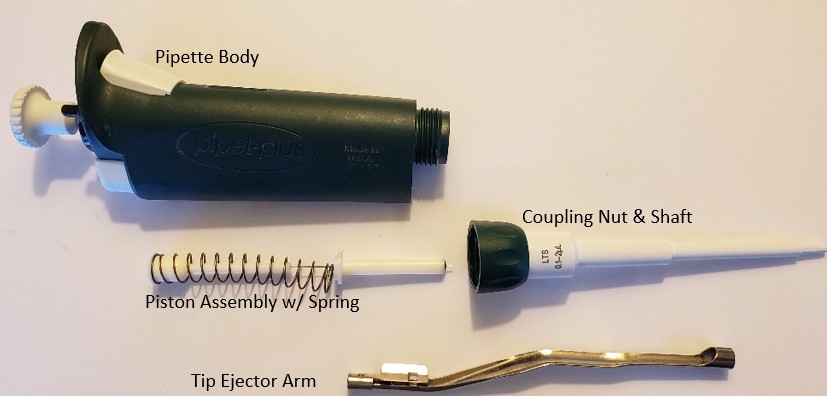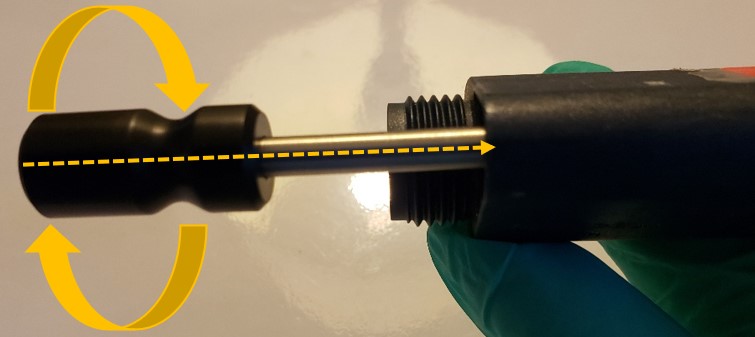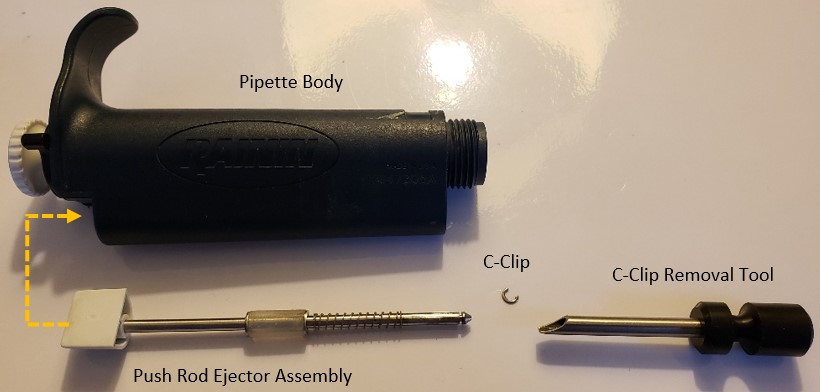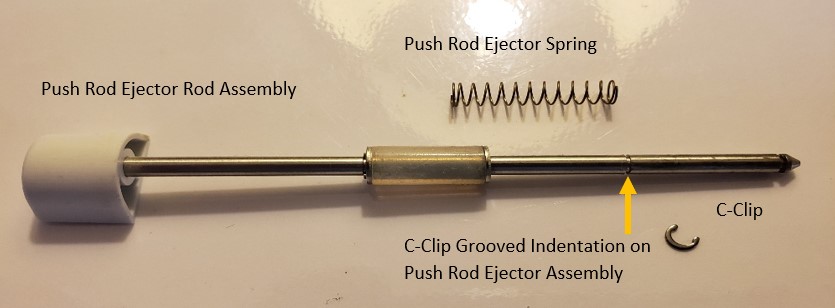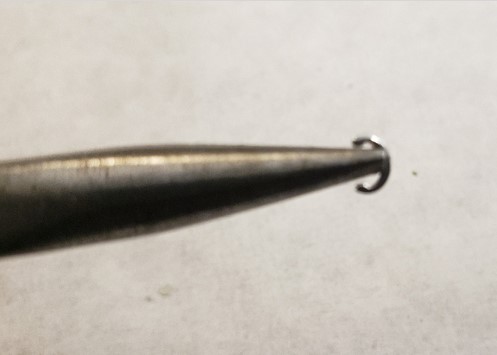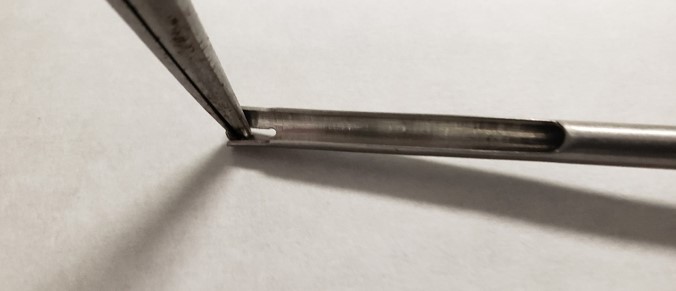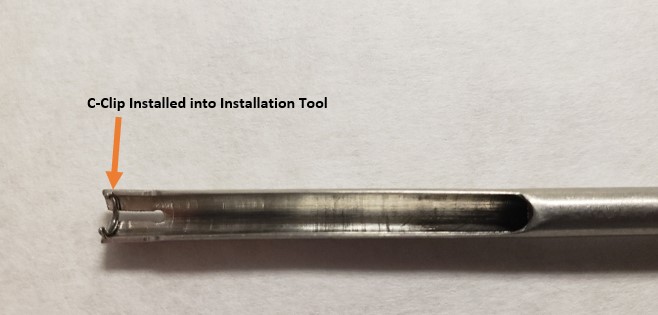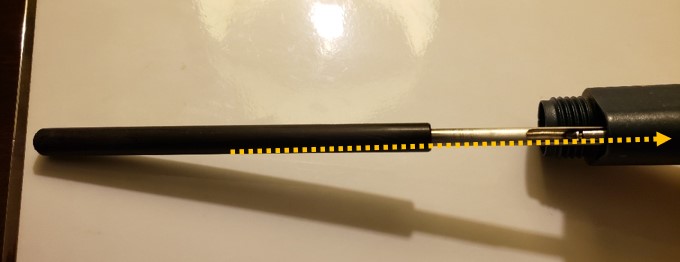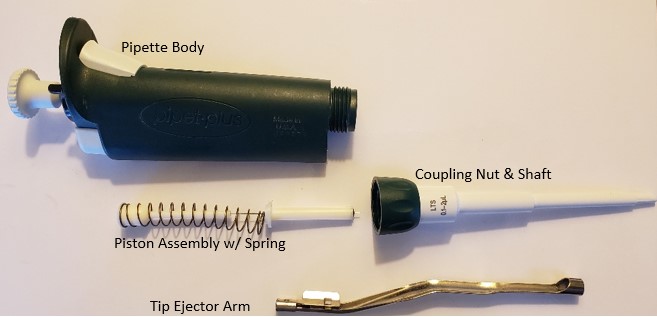The process of removing, replacing, and reinstalling the Rainin Push Rod Ejector Assembly requires great care, a high attention to detail, patience, and steady hands. Please dedicate a good work area with good lighting and space where small parts can be located should they pop/fly out during disassembly. Pipette damage and lost parts may occur if attention to detail is not maintained. Please proceed at your own risk.
These instructions are applicable for the following pipettes (single and multichannel):
- Pipet-Lite (NOT APPLICABLE FOR PIPET-LITE XLS/XLS+. For Pipet-Lite XLS instructions, click here) (Ejector button not sold by Pipette Supplies)
- Pipet-Plus (Different ejector button, not sold by Pipette Supplies)
- EDP1 (Different ejector button, not sold by Pipette Supplies)
- EDP3 (Different ejector button, not sold by Pipette Supplies)
- RAININ Classic (Different ejector button, not sold by Pipette Supplies)
Recommended Service Tools
The following tools pictured here are strongly recommended to properly service, repair, or replace the Rainin push rod ejector assembly and/or the internal volume assembly.
- Needle Nose Pliers
- Bent Nosed Pliers: PS 10007 (Only required if completing the optional counter assembly replacement instructions)
- C-Clip Insertion Tool: PS 10005
- C-Clip Removal Tool: PS 10006
- Replacement C-Clips: PS 1555C
Pipette Supplies does not current sell replacement Rainin Pipet-Lite (NON-XLS) Push Rod Ejector Assemblies.
Rainin Push Rod Ejector Disassembly Instructions
Step 1:
Remove the tip ejector arm from the pipette by pressing in and down on the butterfly clips. Once removed, lay the tip ejector arm aside for reassembly later.
Step 2:
Unscrew the shaft coupling nut. Remove the shaft and internal piston assembly.
CAUTION: Be careful when unscrewing the coupling nut. The piston spring is under tension and may fly out with the piston assembly parts.
Lay the piston assembly, shaft, and shaft coupling nut next to the tip ejector arm for reassembly later.
Step 3:
Locate the C-Clip removal tool. The C-Clip is the part that will be removed by the removal tool in step 4. Be careful to not lose the c-clip when removed, it can easily fly out of the pipette.
Step 4:
Press and hold down the tip ejector button to partially expose the pointed portion of the push rod assembly from the pipette body.
Step 5:
Fully insert the c-clip removal tool into the pointed portion of the push rod ejector assembly.
Step 6:
Once the c-clip removal tool is fully inserted into the Rainin push rod ejector assembly, twist the c-clip removal tool handle to dislodge the c-clip from the push rod ejector assembly. Begin by turning gently and then gradually apply more pressure as needed.
Note: Be prepared to lose the c-clip. Replace the c-clip as needed.
Step 7:
With the c-clip removed from the push rod ejector assembly, slide the push rod ejector upward to remove it from the top of the pipette body.
Step 8:
Examine the Rainin push rod ejector assembly components with a special emphasis on the grooved indentation on the push rod.
Note: The grooved indentation is the location where the c-clip will attach to during reassembly. The c-clip provides tension to the ejector spring, as well as keep the push rod ejector assembly in the pipette body.
OPTIONAL: Counter Assembly Replacement Instructions
Reassembly Process
Step 9:
With the needle-nosed pliers, gently grab and hold a c-clip as shown below.
Step 10:
Insert the c-clip into the grooved indentation on the c-clip installation tool, as shown below.
Step 11:
Notice the c-clip inserted into the grooved indentation on the c-clip installation tool.
Step 12:
Push and hold the ejector button. Gently slide the installation tool fully into the pointed end of push rod ejector rod assembly until the c-clip catches with the c-clip grooved indentation on the push rod ejector assembly. Shown in the picture on step 8.
Step 13:
Push the c-clip tool upward until you hear a slight click of the c-clip snapping back into place.
Step 14:
Insert the piston assembly back into the shaft and screw the shaft coupling nut back onto the pipette body.
Step 15:
Reattach the tip ejector arm back onto the pipette body.
Step 16:
Check your work and correct as needed.
Related Posts:
Seal/O-Ring Vs. Lip Seal for Pipet-Lite, Pipet-Lite XLS, and E4-XLS Models
Pipet-Lite, XLS, XLS+ Calibration Tool, Item # RA CT-2
Rainin Pipet-Lite, Pipet-Lite XLS: How to Tighten a Loose Volume Lock Top
Disclaimer: Any action you take using the information on this website is strictly at your own risk. The information herein does not constitute professional advice and is general in nature. We make no warranty that this information will meet your requirements, be safe, accurate, or error-free. Pipette Supplies, Inc. is not responsible for any errors or omissions, any results obtained from the use of this information, or any loss or damage arising out of the use of this information. This site is for educational purposes only.
Fair Use: Copyright Disclaimer under section 107 of the Copyright Act of 1976, allows for “fair use” for purposes such as comments, criticism, teaching, scholarship, news reporting, and research.
Fair use is permitted by copyright statute that might otherwise be infringing.

